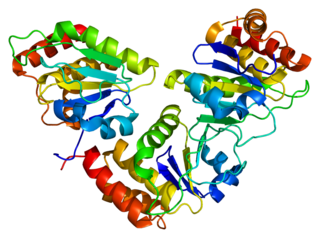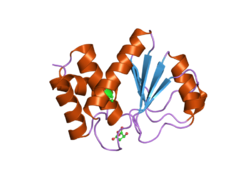A protein phosphatase is a phosphatase enzyme that removes a phosphate group from the phosphorylated amino acid residue of its substrate protein. Protein phosphorylation is one of the most common forms of reversible protein posttranslational modification (PTM), with up to 30% of all proteins being phosphorylated at any given time. Protein kinases (PKs) are the effectors of phosphorylation and catalyse the transfer of a γ-phosphate from ATP to specific amino acids on proteins. Several hundred PKs exist in mammals and are classified into distinct super-families. Proteins are phosphorylated predominantly on Ser, Thr and Tyr residues, which account for 79.3, 16.9 and 3.8% respectively of the phosphoproteome, at least in mammals. In contrast, protein phosphatases (PPs) are the primary effectors of dephosphorylation and can be grouped into three main classes based on sequence, structure and catalytic function. The largest class of PPs is the phosphoprotein phosphatase (PPP) family comprising PP1, PP2A, PP2B, PP4, PP5, PP6 and PP7, and the protein phosphatase Mg2+- or Mn2+-dependent (PPM) family, composed primarily of PP2C. The protein Tyr phosphatase (PTP) super-family forms the second group, and the aspartate-based protein phosphatases the third. The protein pseudophosphatases form part of the larger phosphatase family, and in most cases are thought to be catalytically inert, instead functioning as phosphate-binding proteins, integrators of signalling or subcellular traps. Examples of membrane-spanning protein phosphatases containing both active (phosphatase) and inactive (pseudophosphatase) domains linked in tandem are known, conceptually similar to the kinase and pseudokinase domain polypeptide structure of the JAK pseudokinases. A complete comparative analysis of human phosphatases and pseudophosphatases has been completed by Manning and colleagues, forming a companion piece to the ground-breaking analysis of the human kinome, which encodes the complete set of ~536 human protein kinases.

Prostatic acid phosphatase (PAP), also prostatic specific acid phosphatase (PSAP), is an enzyme produced by the prostate. It may be found in increased amounts in men who have prostate cancer or other diseases.

Mitogen-activated protein kinase 1, (MAPK 1), also known as ERK2, is an enzyme that in humans is encoded by the MAPK1 gene.

Dual specificity protein phosphatase 1 is an enzyme that in humans is encoded by the DUSP1 gene.

GM2 ganglioside activator also known as GM2A is a protein which in humans is encoded by the GM2A gene.

Cyclin-dependent kinase inhibitor 3 is an enzyme that in humans is encoded by the CDKN3 gene.

Dual specificity protein phosphatase 3 is an enzyme that in humans is encoded by the DUSP3 gene.

Receptor-type tyrosine-protein phosphatase N2 (R-PTP-N2) also known as islet cell autoantigen-related protein (ICAAR) and phogrin is an enzyme that in humans is encoded by the PTPRN2 gene. PTPRN and PTPRN2 are both found to be major autoantigens associated with insulin-dependent diabetes mellitus.

Dual specificity protein phosphatase 4 is an enzyme that in humans is encoded by the DUSP4 gene.

Dual specificity protein phosphatase 10 is an enzyme that in humans is encoded by the DUSP10 gene.

Dual specificity protein phosphatase 7 is an enzyme that in humans is encoded by the DUSP7 gene.

Dual specificity protein phosphatase 22 is an enzyme that in humans is encoded by the DUSP22 gene.

Dual specificity protein phosphatase 16 is an enzyme that in humans is encoded by the DUSP16 gene.

Dual specificity protein phosphatase 5 is an enzyme that in humans is encoded by the DUSP5 gene.

Dual specificity phosphatase 13 is an enzyme that in humans is encoded by the DUSP13 gene.

Dual specificity protein phosphatase 18 is an enzyme that is encoded by the DUSP18 gene in humans.

Dual specificity protein phosphatase 12 is an enzyme that in humans is encoded by the DUSP12 gene.

Dual specificity protein phosphatase 15 is an enzyme that in humans is encoded by the DUSP15 gene.

Dual specificity protein phosphatase 19 is an enzyme that in humans is encoded by the DUSP19 gene.

MAPK phosphatases (MKPs) are the largest class of phosphatases involved in down-regulating Mitogen-activated protein kinases (MAPK) signaling. MAPK signalling pathways regulate multiple features of development and homeostasis. This can involve gene regulation, cell proliferation, programmed cell death and stress responses. MAPK phosphatases are therefore important regulator components of these pathways.
























